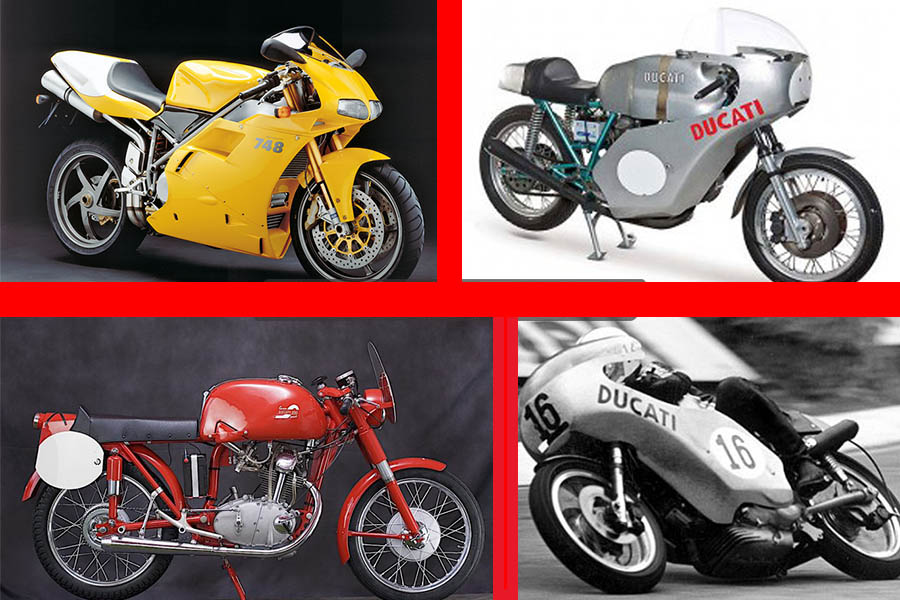
In January 2012, Ducati was recognized as "an asset of historical and cultural interest" by the Ministry of Cultural Heritage and Activities of Emilia Romagna. The award refers to the historical archive and the Ducati Museum. The Historical Duchies that we present are part of this heritage that goes far beyond the passion for motorcycling.
In addition to illustrating the motorcycles and livery that made ducati history, it seems necessary to tell a bit of history of the motorcycle manufacturer of Borgo Panigale.
Historic Ducati: the Borgo Panigale brand and the Desmodronico system
Ducati's history began in 1926, with the foundation of the Ducati Scientific Society of Radio Patents, a research and production company for the radio broadcasting industry.
In 1935, ducati plants were built in the Borgo Panigale district of Bologna.
After the birth in 1939 of the optical section, in the middle of World War II, Ducati was forced to convert civilian production for military use.
In 1946, in the post-war period, the motorcycle department was born that will give birth to the "Cucciolo", a 48 cc single-cylinder engine with auxiliary engine functions for bicycles.
From '52 to '68, Giuseppe Montano contributes to Ducati's entry into the world of sports competitions by designing winning racing bikes from which to develop standard bikes.
The company split in 1954 into Ducati Meccanica (for the production of motorcycles) and Ducati Elettrotecnica. Two years later, engineer Fabio Taglioni created the first Ducati engine with desmodromic valve recall system. Since then, the motorcycle brand has been linked with the Desmo,icon of all its engines.
With the agreement between Ducati and Cagiva,in the early 80s, the era of the Superbike family and the Monster.
In 1996, Ducati was sold and listed on the stock exchange as Ducati Motor Holding spa owned by Texas Pacific Group. The first WDW edition was organized in 1998, the same year as the inauguration of the Ducati Museum.
After the acquisition, in 2012, by Lamborghini, Ducati was integrated into the Audi AG automotive group.
Ducati Storiche: fabio taglioni's models
The engineer Fabio Taglioni, author of over 1000 projects, is due to the twin-cylinder engine with 'elle' configuration and a series of important models:
- 100 Gran Sport (1954);
- 125 Grand Prix Desmo (1956) with which Ducati won in Sweden;
- Ducati 175 andScrambler (early 1960s) that mark the entry of the motorcycle manufacturer into the North American market;
- 750 Desmo (1972),which won the "200 miles of Imola", and the 750 Super Sport series model;
- 900 Super Sport racing (1978) winning the Turist Trophy;
- Pantah 500 (1979).
From the early 1950s onwards, Ducati's successes in the world of motorcycle racing are not counted thanks to motorcycles such as the 851 (which debuts in the SBK World Championship, 1988), the 916 up to the legendary Panigale V4R and the Ducati Desmosedici designed for the 2003 MotoGP championship and which will see the victory of the first rainbow title of 2007 thanks to the victories of the Australian Casey Stoner and the great Italian driver Loris Capirossi.
Iconic Ducati models: from Desmo 125 GP to Panigale variants
What are the iconic models that have made Ducati's history in terms of innovation linked to two wheels? Let us mention them all in chronological order:
- Desmo 125 GP (1956), first motorcycle with desmodromic distribution;
- 750GT (1970s) with twin-cylinder and Scrambler with single-cylinder engines of 125, 250, 350 and 450 cc.;
- 750SS (1974) with a 90° L-engine, which scored several victories and places in the 1974/1975 seasons, often driven by Carlo Saltarelli;
- Paso (1986) designed by Massimo Tamburini, first faired motorcycle;
- 851 (1987), forefather of the 4 liquid-cooled valves;
- Monster M900 (1993) with Superbike 851 chassis, exaggerated engine of 904 cc air-cooled two valves, unique design. The M900 was followed by the lighter, more bile M600, the Monster Chromium and Dark (1998) and the S4R (2004), the 110 Evo with desmodromic engine;
- 916 (1994), twin-cylinder designed by Massimo Tamburini, with positioning of the steering shock absorber covered by a world patent, followed by evolutions 996 and 998;
- 999 (2002), first "on-off" called Ducati Multistrada;
- PaulSmart 1000LE and the Sport 1000 of the Sport Classic series (2005);
- DesmosediciRR, a road replica of MotoGP (2006), with which for the first time the performance and innovative characteristics of racing bikes have been transferred to a road bike. Over 200 hp of power (open exhaust), 4-cylinder L and 989 cc engine, various carbon fiber components, gas fork, carrier hoe frame, single-block brake calipers, "manboard" exhaust;
- 1098 (2007), evolution of the 999, which received several awards including "Best Bike of the Year" 2007, Best Design, Best Motorcycle supersport;
- Hypermotard (2007) with which Ducati enters the world of road motards;
- Panigale (2012), the Ducati jewel, an exclusive superbike in design and performance, with versions equipped with V4 and twin-cylinder engine (899, 1299, V4R). Powerful and light, with an aggressive muzzle and high codon, it devours the street.
2021 is the year of the Ducati Superleggera V4, the only bike approved for road use with chassis, rims and swingarm made of carbon fiber, proposed in a limited edition (500 pieces).
Inside our site you can find a wide assortment of stickers and adhesive graphics of the iconic HISTORICAL DUCATI.
